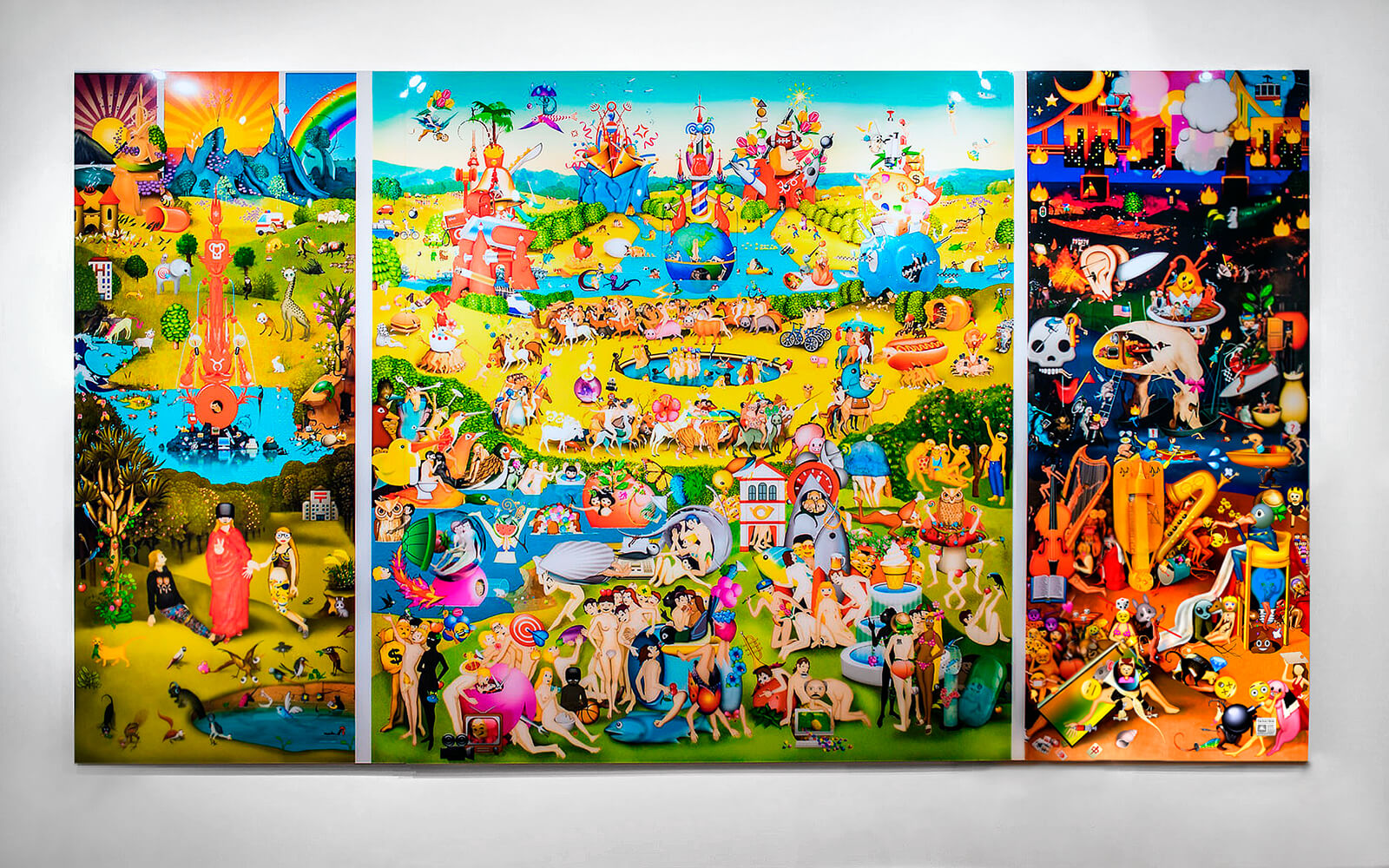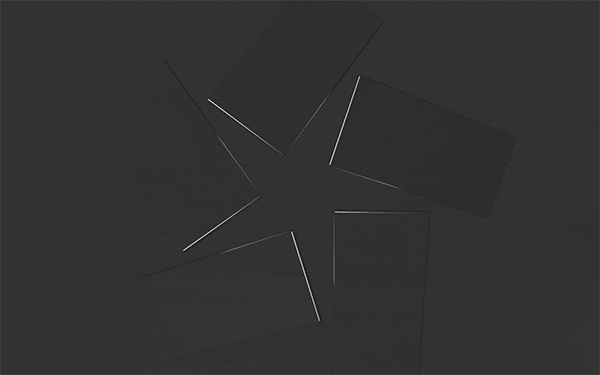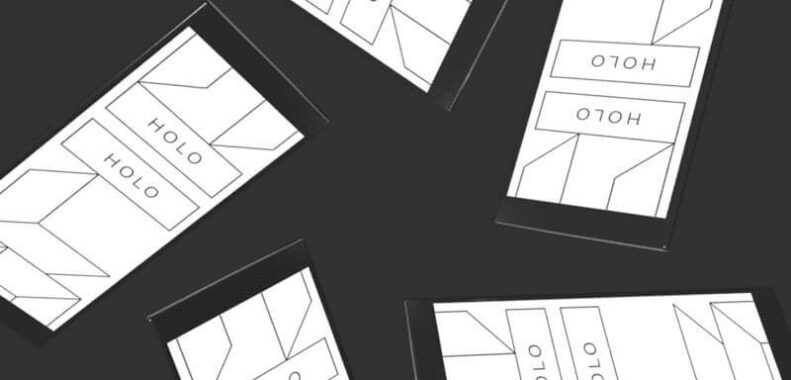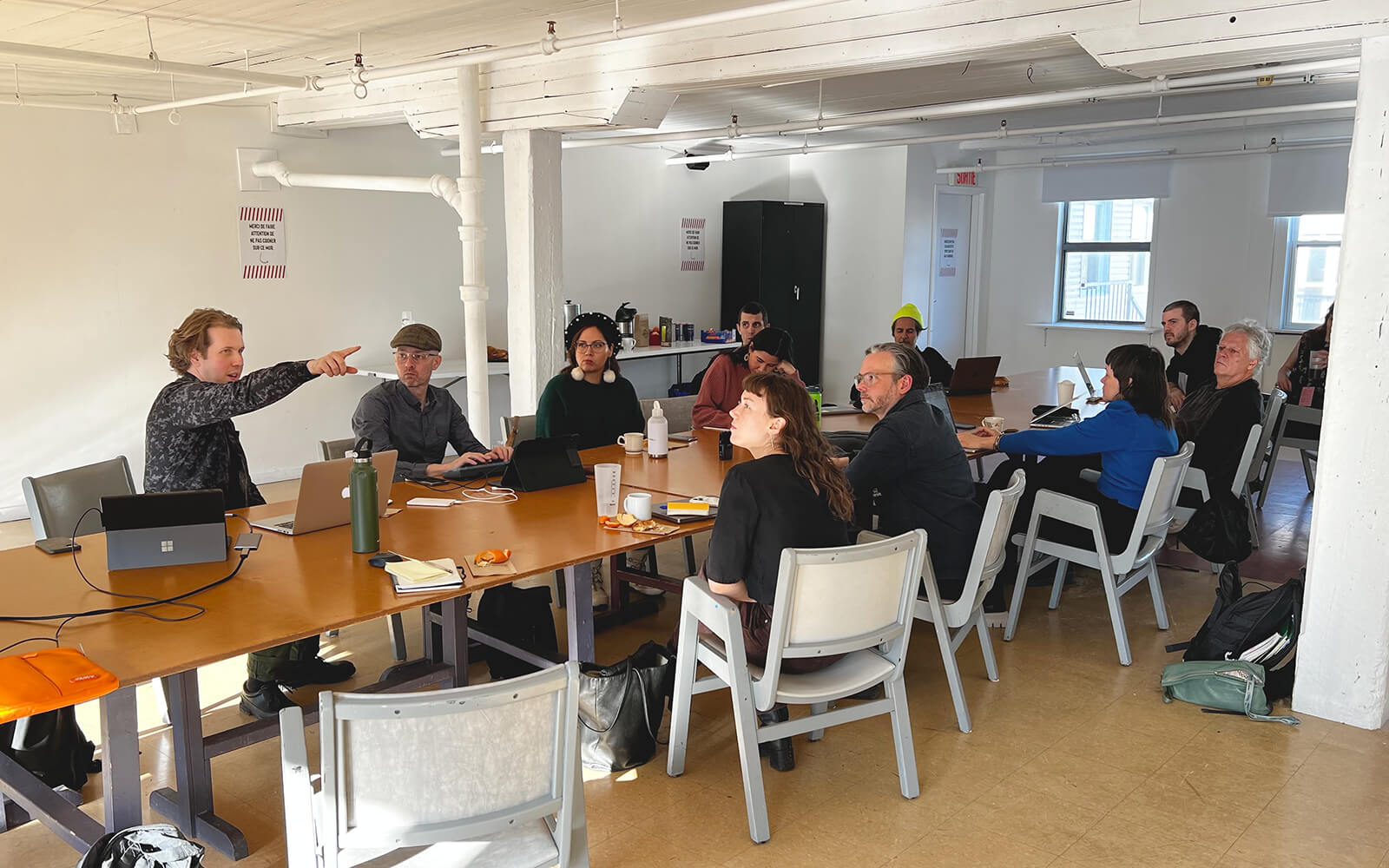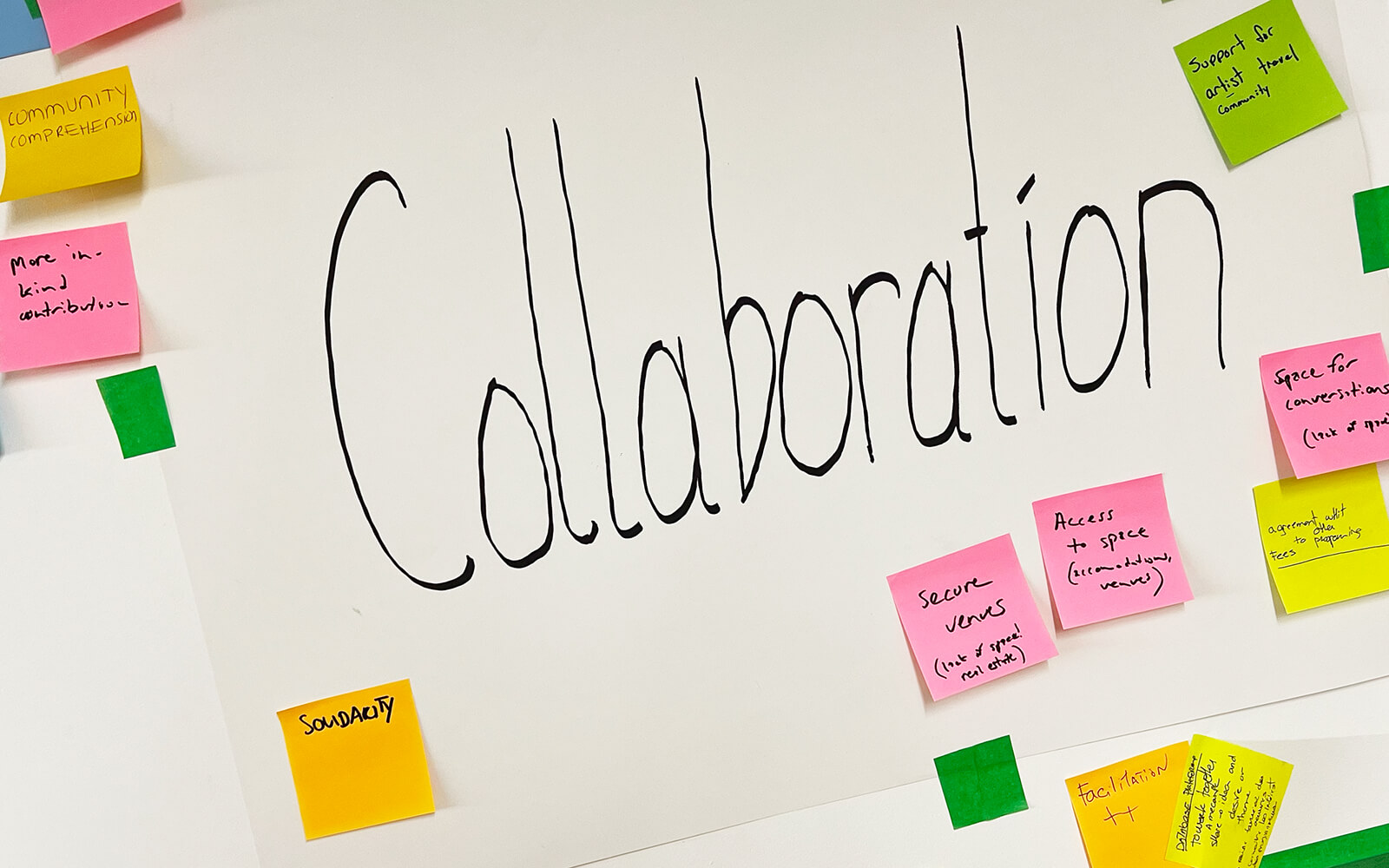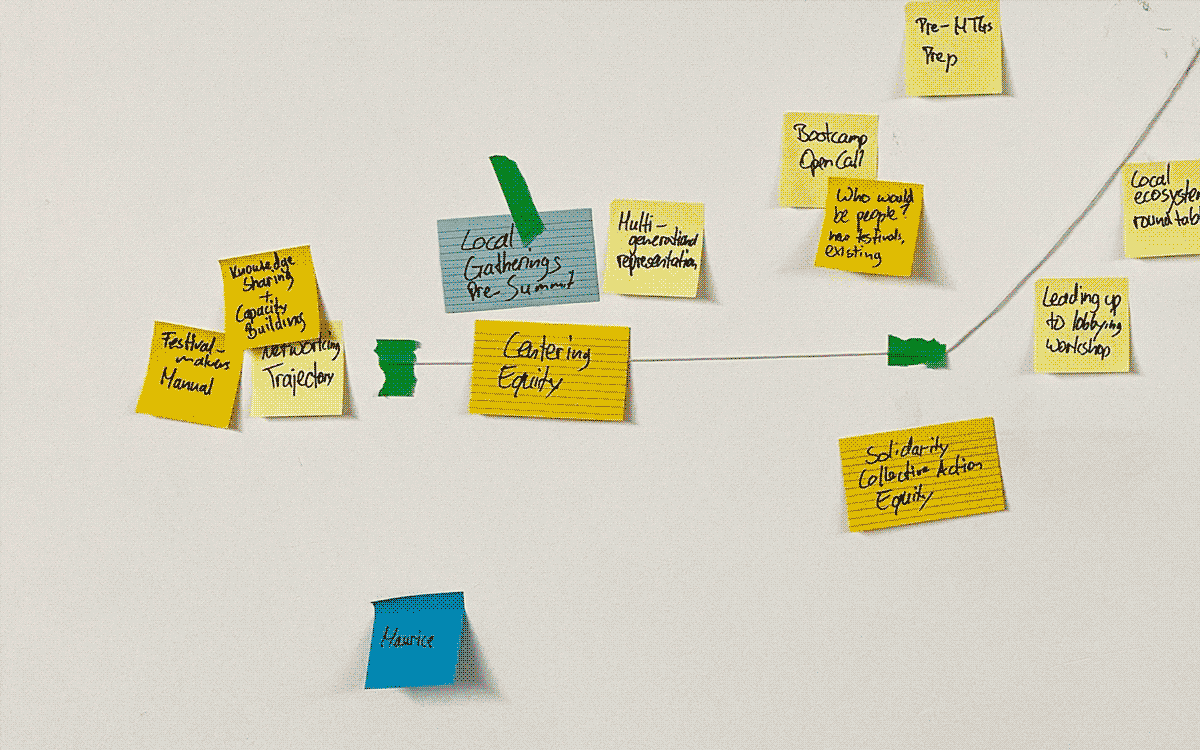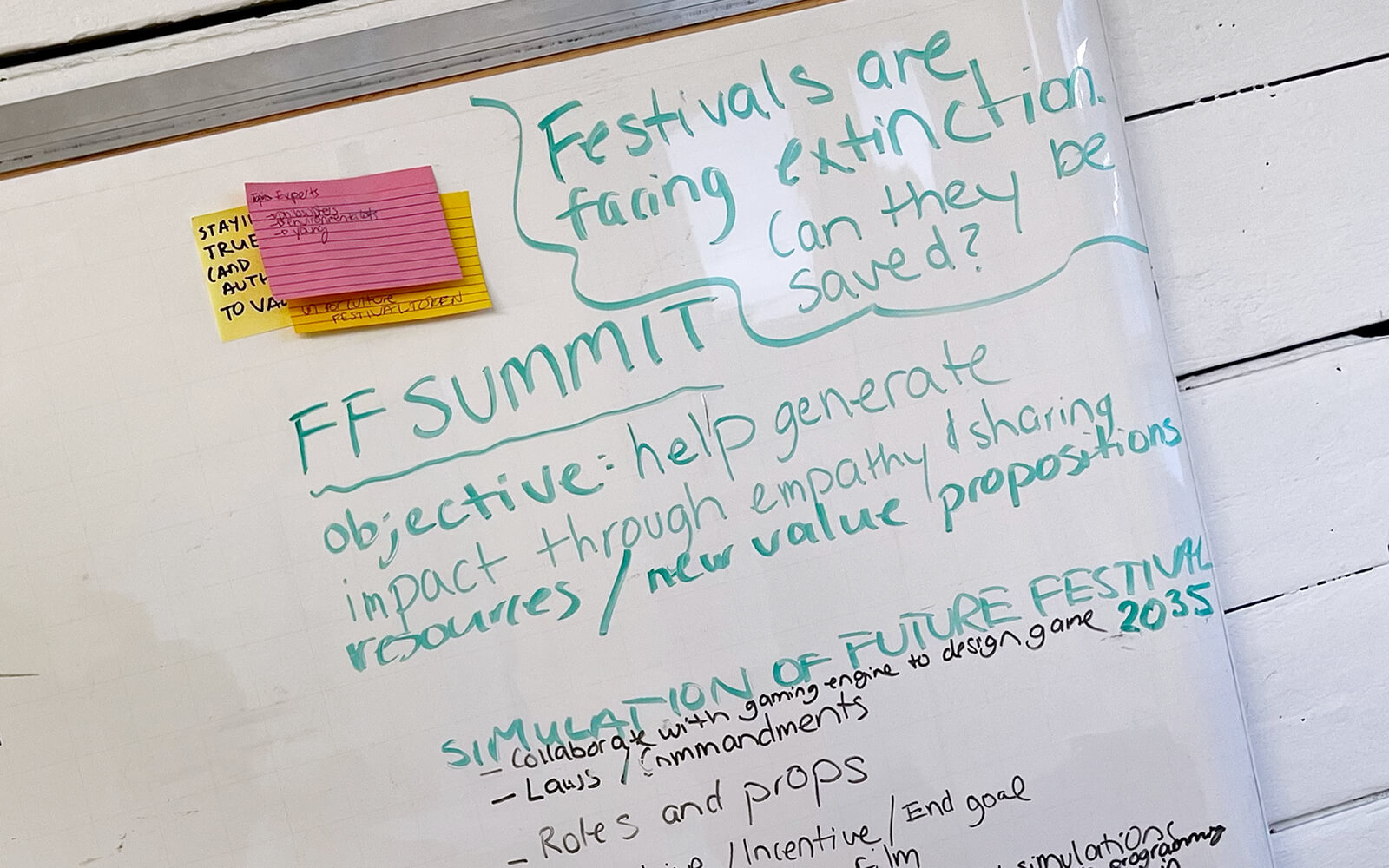All
Daily Discoveries at the Nexus of Art, Science, Technology, and Culture—Join Us!
AI art and biohacks that ponder posthumanism, CGI fever dreams that (further) distort reality, software that speaks truth to power: HOLO explores critical creative practice that emerges between art, science, technology, and society—a space of radical imagination where new ideas and cultural paradigms are born. Join us for daily discoveries by becoming a HOLO Reader.
As a Reader, you enjoy full access to HOLO’s vast content library, including archival pieces from sold out print editions and newly commissioned works:
- Research: read longform analysis and critical commentary from brilliant thinkers like James Bridle, Geoff Manaugh, and Georgina Voss
- Profiles: enter the studios of pioneers and innovators such as Vera Molnar, Mary Maggic, David OReilly, Semiconductor, and many others
- Q&As: get timely insight from curators, artists, and researchers including Claire L. Evans, Kyriaki Goni, Mindy Seu, Yuri Suzuki, and more
- Timeline: browse the HOLO news archive (2,000+ entries and counting) in its entirety
By becoming a HOLO Reader, you also ensure that independent publishing not only survives but thrives: your support funds ad-free public content and helps pay our talented contributors—artists, designers, writers, photographers—equitably. It allows us to invest in new features, more formats, and widen our coverage across the board.

Reader
$40USD/Year
- Full access to online content, including archival pieces and newly commissioned works
- Special discounts on HOLO products
- Automatic yearly renewal until cancelled
Collector
$75USD/Year
- Everything in Reader tier
- One copy of the annual collector’s edition (free shipping)
- Automatic yearly renewal until cancelled
Studio
$350USD/Year
- Everything in Reader tier (20 users)
- Five copies of the annual collector’s edition (free shipping)
- Automatic yearly renewal until cancelled
The Annual Collector’s Edition
Every year, HOLO issues a special collector’s edition that captures the calendar year in print. Collectors automatically receive the edition the following year (with free shipping). E.g. a Collector’s Edition account started or renewed in 2022 receives the edition for that year in 2023.
The Archives (2014–2020)
Adding the content from HOLO’s past print editions—essays, artist profiles, illustrated fiction—online is currently in progress. Readers can expect to have access to the majority of HOLO’s archival content in mid-2023.
A Complexity Primer
“The idea was that a one-to-one collaboration could produce something that neither of the two could individually foresee. And that was the basis for the whole thing, and the system developed from there.” —Experiments in Art and Technology (E.A.T.) founder Billy Klüver in a 1995 interview
Art-science collaborations have a long and storied history. From E.A.T. and Bell Labs in the late 1960s to CERN’s present-day artistic residencies, art can mediate science’s often inaccessible and inscrutable findings. Artists are particularly well-suited to interpret and activate the many powerful forces that swirl beyond our immediate perception.
“Future Tense: Art, Complexity, and Uncertainty,” is a research project, exhibition, and symposium executed by the UCI Beall Center for Art + Technology. Funded by Getty’s 2024 PST ART: Art and Science Collide initiative, it emerges from three years of artist-scientist residencies—collaborations that push both parties out of their comfort zones to yield new forms of artistic research.
Beall Artistic Director David Familian has gathered an exciting roster of artists who harness complex systems across diverse fields including bacterial intelligence, evolutionary biology, data surveillance, global warming, and robotics. At the “Future Tense” exhibition (Aug 24-Dec 14, 2024), Cesar & Lois, Chico MacMurtrie, Laura Splan, Hege Tapio, and Gail Wight will present newly commissioned works developed in the Beall Center’s Black Box Projects residency program. Ralf Baecker, Carolina Caycedo, Julie Mehretu, Fernando Palma Rodríguez, David de Rozas, and Theresa Schubert contribute existing works from their exciting catalogues.
Led by an exciting guest writer, this dossier will parse the complexity, chaos, and rich interdisciplinary collaboration at the heart of “Future Tense.”
Watch this space!
Nothing drives the precarity of the cultural sector home like a festival having its funding cut. After the strong showing by Germany’s major conservative party in the most recent North Rhine-Westphalia elections, Future Festivals associate NEW NOW is unsure if they will return with a third edition of their biennale in 2025. “There’s a real threat of a hard-right shift in the country because mainstream conservative politicians lean into extremist positions to garner votes,” says NEW NOW’s Rafael Dernbach. “But there is a lot of hope as well. Last week, I was with my family and friends at the Reichstag with 150,000 people protesting against far-right populism.”
Populism isn’t the only thing threatening the arts. “I was just in Berlin for Transmediale,” says Future Festival Project lead Maurice Jones. “The opening and its conference was a beacon of hope about what a festival can do in these times of crisis and volatility,” he says, referring to the chilling effect that Israel‘s post-October 7th aggression against Palestine has had on the German cultural sector. “It did a great job of holding space for very difficult conversations that are either actively suppressed or simply don’t happen in mainstream media.”
The above two accounts shared at the beginning of the fourth Future Festivals Lab illustrate why the project matters. A future where the cultural sector even exists is not a given, and even in progressive countries, the climate can change from art-positive to cutbacks, closures, and censuring overnight. Energized and with a new sense of urgency, the group’s participating festival makers and cultural workers reconvened at the project’s pivotal midway point. The task: turn field research and survey data into a plan for action.
Workshop: “Navigating Challenges + Shaping Futures” with Alexander Scholz, Greg J. Smith (HOLO); Naomi Johnson, Kaitlynn Tomaselli (imagineNATIVE); Rafael Dernbach (NEW NOW); Sarah Mackenzie, Alain Mongeau, Maurice Jones (MUTEK); Damian Romero (MUTEK.MX); Emile Beauchemin, Mélanie Bédard (Mois Multi & Recto-Verso); and Cam Scott (Send+Receive)
Tackling inequity, combatting burnout, and reducing the carbon footprint—the Future Festivals working group has identified areas where change is urgently needed. In its lab sessions thus far, topics and approaches including degrowth (NEW NOW), radical access and inclusivity (MUTEK), and asserting Indigenous narrative sovereignty (imagineNATIVE) were foregrounded and these ideals remain top of mind. Mois Multi marked a crucial midway point for the project as after numerous workshops and consultations, it was time to move on from blue-sky brainstorming toward tangible outcomes.
Sequestered away in a sunny, upper-level, large open workspace in the La Charpente des fauves art space, the group gathered around a long table. “The work we’ve done thus far in the project has set us up for this,” says Jones. “Today we finalize the purpose and outcomes of the Future Festivals Project.” To do that the group plumbed the depths of the frustrations aired in the cultural worker ‘group therapy’ sessions over the last year. “Tensions can be described as a discrepancy between what is and what could be,” says Dernbach, introducing the morning session. “We will map these tensions, and then we’’ll massage them.”
Over three hours, the group broke into small groups to brainstorm a list of ‘things they need,’ either as festival makers or cultural workers. Then, tangible interventions were imagined—actions that could deliver those desired outcomes. The conversations to identify those interventions were passionate and wide-ranging, with groups fervently discussing everything from levelling up political advocacy to creating cryptocurrencies to meet the needs of the cultural sector. The following key points represent some of the tensions and proposed interventions that were identified.
Tension: Festivals struggle to capture and maintain attention under platform capitalism, as communication with audiences gets lost in algorithmic timelines and social media noise. This lack of ‘discoverability’ of the value festivals create results in their being (relatively) invisible locally despite their national or international importance.
Intervention: Prioritize (more) direct communication with audiences and don’t try to compete in the attention economy. Festivals proactively build bridges to local communities and arts organizations to grow the audience in their own backyard.
Tension: Festivals suffer from a generation gap, externally with younger audiences and internally between senior and junior employees. Differing generational expectations around programming, governance, and equity create fault lines within organizations.
Intervention: Develop multigenerational representation in both the artists being programmed and across governance to create buy-in from stakeholders of all ages. Build consensus and spaces of agency for younger team members to instill a love for the work across the entire organization. Prioritize meeting younger audience members and workers where they are to ensure long-term relevance.
Tension: On the left and centre, very few politicians champion the arts—and right-wingers have been known to attack the sector as wasteful to score political points. A lack of national, regional, and municipal advocates makes the arts perpetually vulnerable to cutbacks, austerity, and critique.
Intervention: Emulate the lobbying tactics of bigger industries. Consult with past (and future) culture ministers to learn how to lobby, find allies within institutions, and what kind of communications strategies impact discussions withinwithiin the halls of power. Change consensus thinking so the positive economic and mental health benefits of the arts are common knowledge. Work towards a fixed percentage of GDP being dedicated to the arts as an enshrined policy to protect against cuts based on who gets into office.
Tension: Within festival teams, there is seldom time or funding to investigate and develop partnerships with other organizations. When partnerships are established, they are fragile and easily lost due to staff turnover. Organizations are constantly scrambling to develop short-term partnership solutions.
Intervention: Festivals with similar mandates and/or programming team up and ‘share’ a dedicated partnership lead over an extended (e.g. 5-year) contract. In a well-funded and purpose-built role, this individual works to create bigger long-term partnerships that connect and support multiple organizations over longer timeframes.
Tension: The high demands and low compensation in the cultural sector are stressful for workers. Varying life-work balance expectations across generations and the difficulty of juggling parenthood with a career in the arts create HR challenges.
Intervention: Block out time within regular duties for employees to develop their skills and explore their curiosities. Provide bespoke flexibility for employees with children so they can excel at parenting. If the arts cannot compete with the private sector on compensation then it should do so on values and quality of life.
The biggest lesson from the project’s research phase is, perhaps, that there’s a need for continued conversation. But conversations require designated spaces and supportive infrastructure. An annual summit, for example, could bring together festival makers and cultural workers to share knowledge, upgrade skills, and build alliances. It’d be a festival for festival makers: designed around solidarity in the cultural sector and geared towards producing solutions to shared challenges.
The good news: The first iteration of such a gathering is already in the making. The Future Festival Summit will take place on August 19th and lead into MUTEK Montreal’s 25th anniversary edition. A whole day of activities will platform innovators in the cultural sector and present a whole catalogue of case studies to draw and learn from. That at least is the goal, said Future Festivals lead Maurice Jones. “And who better to workshop ideas with than the festival brain power assembled in this room?”
Putting their heads together, the group began sketching summit sessions that balance engaging sharing formats that foster openness and generosity with hands-on, impact-driven learning exercises run by experts. “I’d really want to take away applicable knowledge and learn new skills rather than hearing about how everything sucks again,” Naomi Johnson exclaimed with good reason. As past sessions have shown, group therapy is important, cathartic even, but it can only ever be the first step.
Bootcamps for festival workers were, therefore, an integral part of many proposals. Some matched veteran directors with young or aspiring festival makers in problem-orientated mentoring sessions. Others zoomed in on the nitty-gritty of lobbying, community building, and organizational bootstrapping. The most ambitious idea was that of a Future Festivals Academy, an extended skill-building framework that covers the full spectrum of cultural work from beginners workshops to masterclasses.
A Future Festival Summit is, of course, also family-friendly. Neither organizers nor attendees should have to decide between their kids and the arts. That’s why a proposed on-site kindergarten offers childcare during festival hours while work-life-balance coaches host counselling sessions for parents. And why not involve kids directly in the summit’s visioning sessions? After all, they’ll have to live with the festival infrastructures we set up today.
Building on the earlier discussions about political literacy, a desired guestlist of stakeholders to invite to the summit was drafted. At the top were representatives from the major funding bodies and Canada’s Culture Minister. What better way to drive home the state of the sector and its potential than to get key decision-makers in the room? Working outside the system, a ‘day without the arts’ was floated as a sector-wide programming blackout to get media attention and signal to the public that the arts sector is facing major challenges.
The most exciting proposal turned the summit into a LARP or live-action role-playing game. A theatrical intervention set in the year 2035 has attendees negotiate festival futures in different stakeholder roles to create empathy and derive new value propositions. Artists, for example, would assume the responsibilities of policymakers and funders would find themselves in the shoes of (precarious) cultural workers. The challenge: “Festivals are facing extinction! Can they be saved?”
The threat of extinction also raises important questions about the afterlife of festivals. If a festival indeed does go under, like NEW NOW may well have, then how can we preserve its contributions? Too many impactful initiatives have disappeared without a trace. A Future Festival Summit, the group argued, should also include a primer on archiving and conservation.
Not all of these ideas will make it, of course. After all, the scope of the first Future Festivals summit is limited by budget—not imagination. However, if anybody can create magic within tight constraints, it’s festival makers. If you are one: Mark your calendar, get involved via futurefestivals@mutek.org, and if you haven’t already, participate in our survey.
The 60th International Venice Biennale opens in Italy with its usual dynamic roster of global talent. Excitingly, Archie Moore populates Australia’s pavilion with kith and kin (2024, image), a dizzying “holographic map of relations” charting 2,400 generations of the artist’s Indigenous ancestry and its many ties to the living world. Other pavilions of note include Hungary (Márton Nemes), Iceland (Hildigunnur Birgisdóttir), and Lithuania (Pakui Hardware & Marija Teresė Rožanskaitė).
Jathan Sadowski Admonishes “Death Drive” Underlying Israeli AI System
“There is a death drive in all of this. It is a drive to lethality. It is a drive towards self-destruction but also the destruction of all others. That is what underlies these systems.”
An immersive, data-driven experience that links fluvial systems, glaciers, and climate change, Theresa Schubert’s solo exhibition “Melting Mountains” opens at MEINBLAU, Berlin, bringing together all three parts of The Glacier Trilogy (2021-22) for the first time. In it, the German bio artist draws on field research in the Western Alps to synthesize fictional archives of snowy peaks, trap ancient meltwater in hand-blown glass sculptures, and drive simulated glacial water systems with visitors’ CO2 exhalations.
Jakob Kudsk Steensen’s installation, The Ephemeral Lake (2024), premieres at Hamburger Kunsthalle, reinterpreting the landscapes of 18th century Romantic painter Caspar David Friedrich as immersive, computer-simulated ecologies. The piece explores themes of water, deep time, and crystallization, Steensen says, and “goes beyond contrasting the human figure in the environment.” Instead, it invites a worldview “where our bodies and minds merge with environmental energies and other species.”
Shu Lea Cheang’s Queer Sci-Fi is Loved By Critics, Hated by Distributors
“I can’t help you with your film because people just want a gay film or lesbian film, and this mixture of sexuality in your film is just not going anywhere.”
Gala Porras-Kim’s Art is at Odds with Institutions
“How do we move from just prioritizing the material, when there are some things beyond the material that could be preserved better? What are the conservation directions for something that is installed in your head?”
Angela Washko’s Autobiographical Videogame About Maternal Healthcare and Parenting Culture Opens as Time Square Solo Exhibition
Angela Washko’s solo exhibition “You Are: Mother, Player” opens at Public Works Administration, a digital art gallery on New York’s Time Square. The show centres on Washko’s narrative videogame, Mother, Player (2022), in which the American artist and educator shares her experiences of pregnancy and motherhood during the pandemic. “Players explore the maternal healthcare industry and parenting culture as a burnt out pansexual artist who has decided to have a child despite a geopolitical climate that deprioritizes and devalues care.”

Geographer Duo Brings Militarized U.S. Border with Mexico into Focus
“Our challenge has been to find a way to disrupt this banality visually, to reframe the material landscapes of surveillance in ways that pull this infrastructure back into focus.”
Drawing inspiration from the simplest of pixel aesthetics, Shinji Murakami’s solo exhibition “2600” opens at New York’s NowHere. Down the Atari 2600 rabbithole since 2021, Murakami makes and mods 2600 games; at NowHere the Japanese artist builds bridges between his hobby and his art practice. The show presents recent acrylic paintings rendered in the 8-bit style (image: Pattern (Pizza Boy), 2024), and some are accompanied by a QR code for viewers to scan, and then play Murakami’s retro videogame creations.
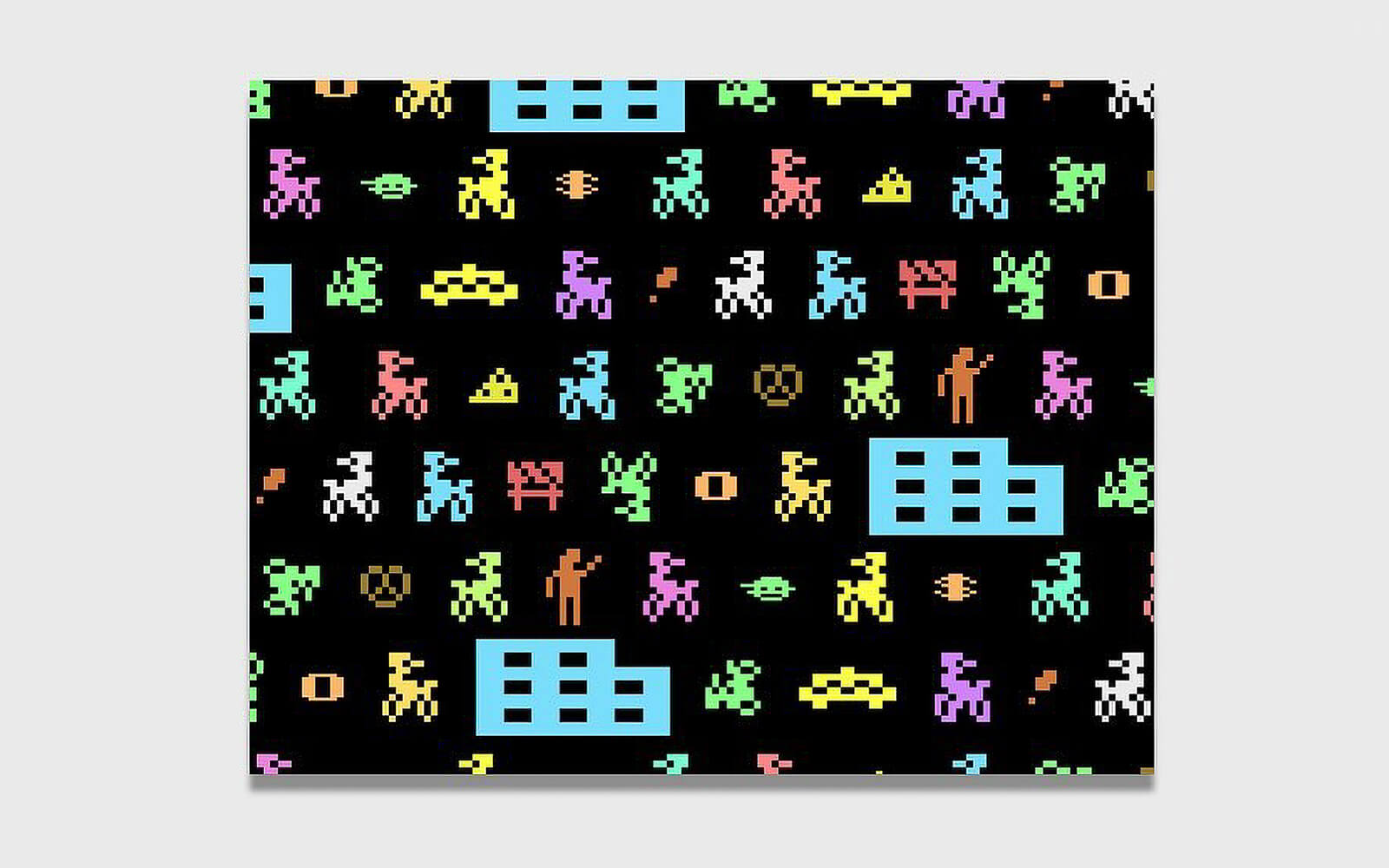
Presenting a new body of sculptures and murals, Auriea Harvey’s “The Unanswered Question” opens at bitforms in New York City. Artfully staged, the Rome-based artist juxtaposes totemic sculptural forms with collages brimming with art historical fragments under contrast-amplifying yellow light. In The Sacrifice (2024, image right), for example, one of Harvey’s figurines is pastiched into chunks of 3D-scanned wall frescoes—“not as simulacrum, but as a suspension of disbelief.”
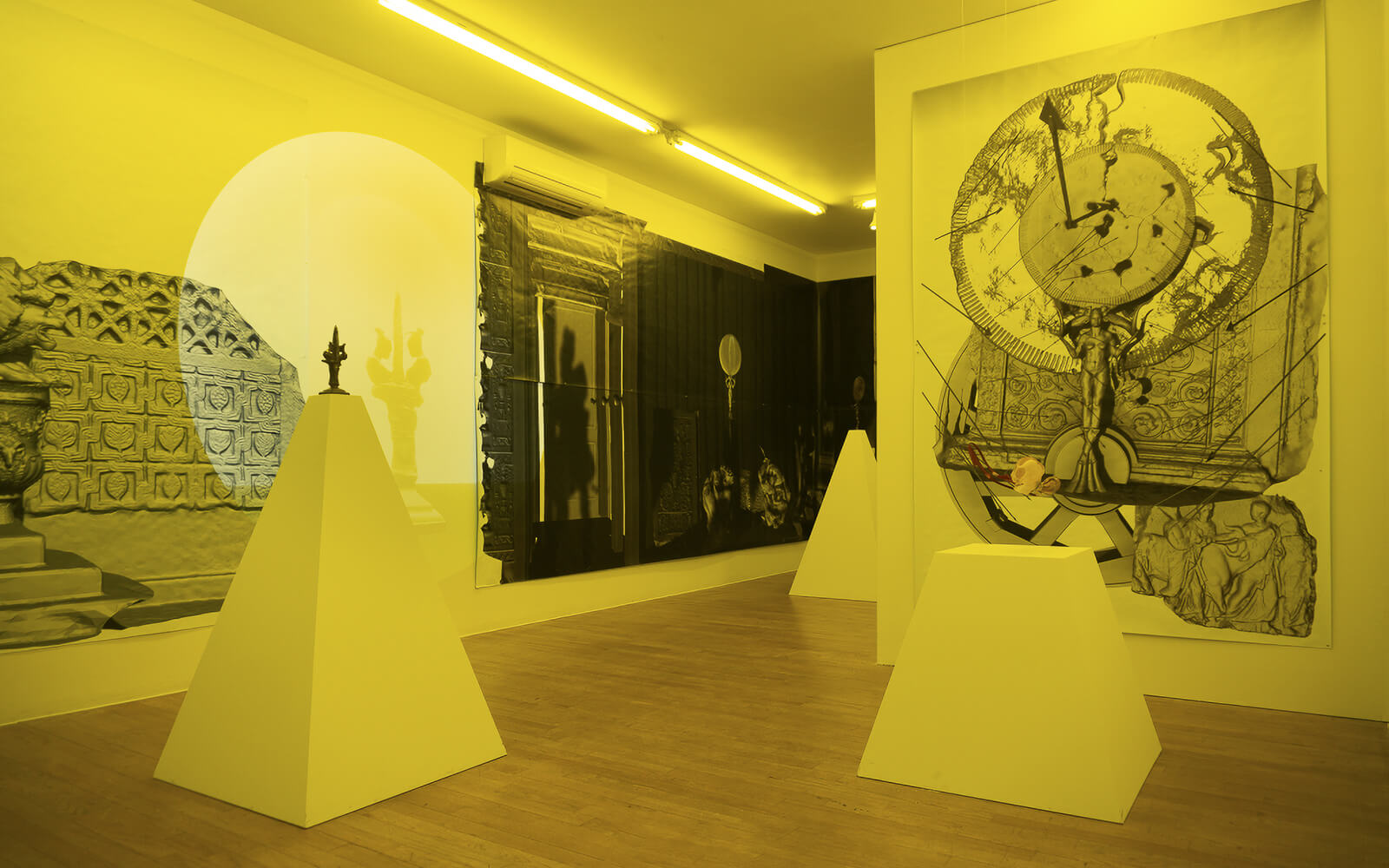
Jon Stewart Tells FTC Chair Lina Khan About Corporate Censorship
“I wanted to have you on and Apple asked us not to do it. They literally said, ‘Please don’t talk to her.’ Like, what is that sensitivity? Why are they so afraid to even have these conversations out in the public sphere?”
March 2024
March 2024
For Ed Yong, Birding is an Act of Resistance and Self-Care
“I don’t need to know who the main characters are on social media and what everyone is saying about them, when I can instead spend an hour trying to find a rare sparrow.”
Foregrounding food production and consumption, Deirdre O’Mahony’s “The Quickening” opens at Trinity College Dublin’s Douglas Hyde Gallery. In its eponymous film (2024, image), the Irish artist documents years of consultation with farmers and policymakers, conveying the “reality of farming and the centrality of soil to human, animal, and insect life.” Kicking off a tour, O’Mahony will subsequently screen the film in Carlow, Waterford, Kilkenny and other towns across Southern Ireland.
Dani Ploeger’s solo exhibition “Destructive Circuits” opens at V2_, Rotterdam, surveying works from his long-running research into the appropriation of everyday technology for homemade weaponry. According to the UN, so-called Improvised Explosive Devices (IEDs) kill thousands every year and profoundly impact security. Ploeger illuminates IED construction, their history, and links to globalized techno-consumerism and media politics with the display of trigger systems, timer devices, a sci-fi short, and an interactive sculpture that ‘blows up.’
Shrimp Jesus Heralds the End of Truth
“This is what happens when you deprioritize news on a platform. You don’t actually get less news. You just get more Shrimp Jesuses.”
Italian game developer, artist, and educator Paolo Pedercini releases The New York Times Simulator (2024), a fast-paced browser game where players steer the news titan’s fortunes as editor-in-chief. Inspired by Lucas Pope’s 2012 Flash game The Republia Times, Pedercini’s parody game problematizes corporate media and propaganda. The goal: Align front page contents and headlines with powerful interests to “lead the most trusted newspaper through our tumultuous times and into the digital age.”

The TRANSFER Data Trust reports the record-breaking acquisition of Carla Gannis’ digital triptych The Garden of Emoji Delights (2014)—a new high for womxn artists on the Tezos chain. Sold for 32,221 XTZ, or $45,000 USD, the NFT of the internet-age take on Hieronymus Bosch’s iconic 16th-century altarpiece comes with the original, 4 metre-wide print Gannis premiered at her 2014 TRANSFER gallery solo show (image). Instead of biblical immorality, the piece depicts the ‘sins’ of contemporary consumer culture.
